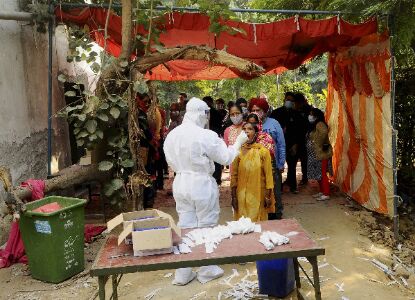Covid vaccine wastage in India is 6.5%, says Centre

New Delhi: The average COVID-19 vaccine wastage in India is at 6.5 per cent, with Telangana and Andhra Pradesh being on the top with 17.6 and 11.6 per cent wastage respectively, the Centre said on Wednesday as it called for optimal utilisation of the doses.
At a press conference, Union Health Secretary Rajesh Bhushan said that Monday, 8.34 million COVID-19 vaccine doses were administered worldwide, of which India alone administered 36 per cent of the doses.
Bhushan said COVID-19 vaccine wastage in five states -- Telangana, Andhra Pradesh, Uttar Pradesh, Karnataka and Jammu and Kashmir -- is higher than the national average of 6.5 per cent.
"The message we have shared with states is that vaccines are invaluable commodities. They are public health goods and therefore vaccines have to be optimally utilised.
"Vaccine wastage has to be drastically reduced. Any reduction in wastage means that you end up inoculating more people and therefore the chances of disrupting the chain of infection grow that much more," he said.
About the increase in daily COVID-19 cases, Bhushan said from March 1-15, about 70 districts in 16 states have registered more than 150 per cent increase in active cases while 55 districts in 17 states have registered a 100-150 per cent rise in cases.
Most of these districts are in west and north India.
Elaborating on the rise in cases in states, he said, "If we look at Maharashtra, 60 per cent of all active cases and 45 per cent of new deaths are concentrated there."
"On March 1, 7,741 new cases were being reported on an average. By March 15, it stood at 13,527. The positivity rate, which was 11 per cent on March 1 rose to 16 per cent by March 15," he said.
Noting that the high positivity rate is a matter of concern, Bhushan said the number of tests is not increasing in tandem with the COVID-19 positivity rate. "So, our advice to the states, especially Maharashtra, is that there is a need to increase the testing rate, especially the RT-PCR ones," he said.
In Punjab, on March 1 an average of 531 new cases were being reported. By March 15, the number increased to an average of 1,338. The positivity rate has doubled and the share of RT-PCR total tests conducted was 89 per cent, he said.
"We would want a distinct increasing trend of tests in which RT-PCR share is substantially higher," Bhushan said.
In Chattisgarh, on March 1 an average of 239 new cases were being reported. By March 15, the number increased to average 430. The positivity rate increased from 1.4 per cent to 2.4 per cent and RT-PCR share in tests conducted is 34 per cent.
In Gujarat on March 1, an average of 398 new cases was being reported. By March 15, the number increased to 689. The positivity rate increased from 2.4 per cent to 4 per cent and RT-PCR's share in COVID-19 tests was 50 per cent.
Karnataka had 443 cases on average on March 1. In a fortnight, the number increased to an average of 751. The positivity rate increased from 0.8 per cent to 1.3 per cent and RT-PCRs' share in COVID-19 tests is 93 per cent.
In Madhya Pradesh, an average of 334 new cases were being reported on March 1. By March 15, the number increased to 564. The positivity rate has increased from 3.1 per cent to 7.4 per cent and RT-PCR share in tests was 65 per cent.
As for Haryana, an average of 151 new cases were being reported on March 1. By the middle of the months, the number increased to 374. The positivity rate has increased from 1.2 per cent to 3.3 per cent and RT-PCR's share in tests was 93 per cent. In Delhi, on March 1 an average of 198 new cases were being reported. By March 15, the number increased to 371.



